Metadata harvesting
Overview
Metadata harvesting is the process of gathering metadata from a data source that exists in your system and is supported by TDV and store it as an EBX® Metadata Management application asset.
You can run harvesting for data sources that are already configured in the TDV or for the new sources defined in the EBX® Metadata Management application.
If you start the Harvesting service from an asset or a selection of assets, please, make sure that all assets were previously harvested by the Metadata agent.
If you start the Harvesting service from an instance or a selection of instances, you can create a data source in TDV for any that do not yet exist. See Create data source from instance for more information.
The Harvesting service cannot be run on disabled assets or instances.
Start harvesting service
On the asset hierarchical view or instance view, select one or more assets or instances for which you want to harvest metadata. Select the cloud icon to begin harvesting. The harvesting main view displays.
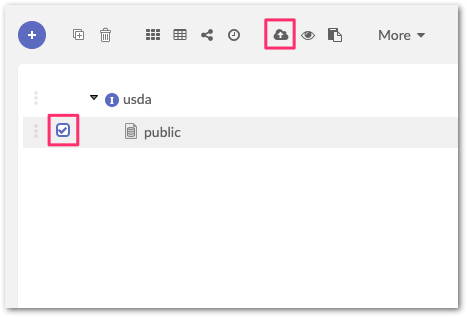
Harvesting main view
The harvesting main view displays your current selection and existing configurations.
An existing configuration is a harvesting that was already executed for one or several elements related to your current selection. If no existing configuration is available you will see a main view similar to the one in the screenshot below:
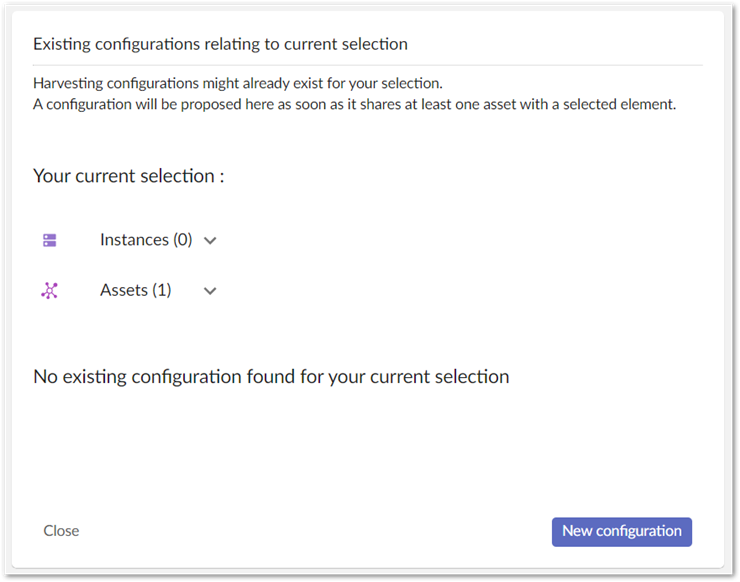
If you have an existing configuration, you will see something like the screenshot below:
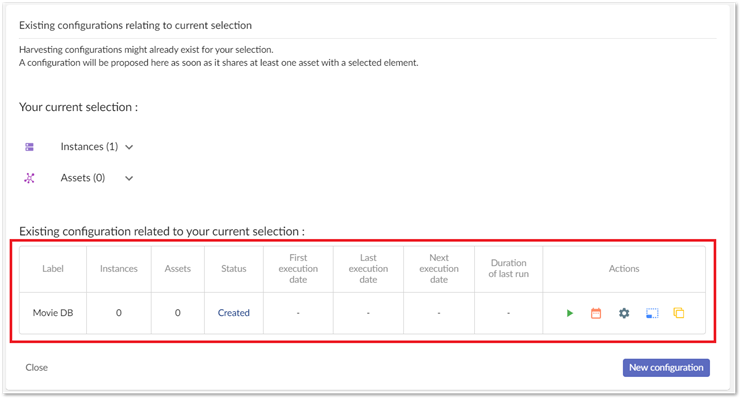
From an existing configuration, you can perform the following actions:
Run
Schedule
Configure
Duplicate
Extend with current selection
See Use an existing configuration for more information.
Create a new configuration
From the main view, click on the bottom right New Configuration button. The new configuration screen displays.
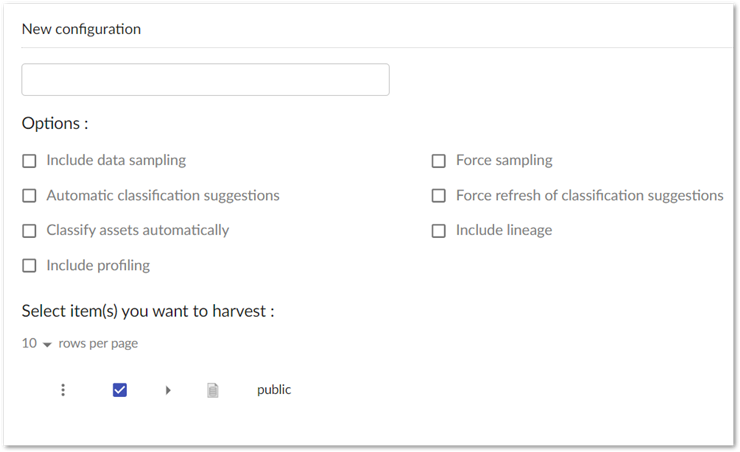
In this screen, start by adding a configuration name. This is necessary for displaying more actions.
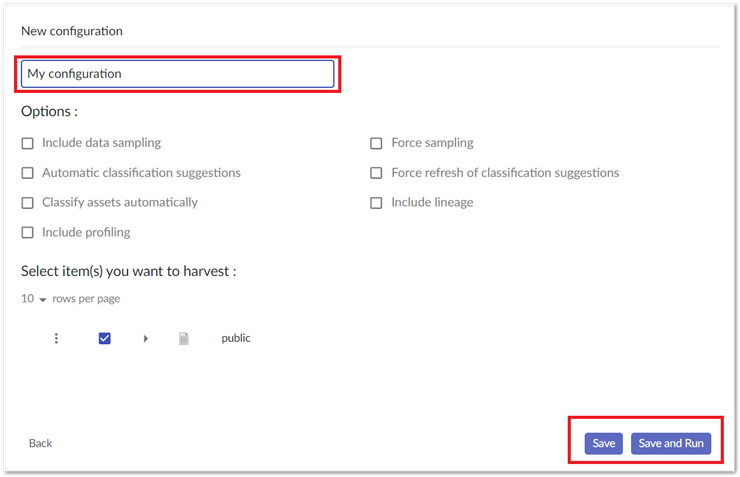
On the top of this screen, you can see options:
Include data sampling: for the assets eligible for sampling harvesting will retrieve data samples from the source system, if available. See Asset sampling for more details regarding supported types.
Force sampling (activates Include data sampling automatically): force data sampling on your assets (overwrite existing samples).
Automatic classification suggestion: the harvesting will also start the classification of your assets.
Force refresh of classification suggestion (activates Automatic classification suggestion): if your asset already has a classification suggestion, this option will force the harvesting to update it.
Classify assets automatically (activate Automatic classification suggestion): Apply the classification suggestion to your asset instead of giving you a list of potential matches.
Include lineage: if your harvesting contains assets of type TDV Published View, the lineage will be extracted and stored for them. As lineage can be quite complicated and concern a large number of resources, it is recommended to activate this option only for scheduled runs, not for immediate harvesting executions.
Include profiling: for eligible assets (DB tables, CSV files, Excel worksheets) cardinality statistics and other profiling information will be included in the harvesting results. As queries for statistics can be time consuming on large data sources, it is recommended to activate this option only for scheduled runs, not for immediate harvesting executions.
In the hierarchical view, you can perform multiple actions:
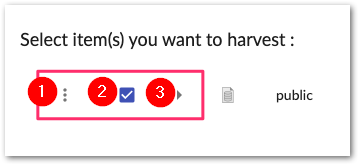
1) | This action allows you to unselect all children and keep the parent node selected. This is only available if the node has children. |
2) | Select or unselect the node for harvesting. If the node has children, this action will also select/unselect all children. |
3) | Expand more or expand fewer children. Clicking on this icon will display children if they exist, if not you will see No data message. If you have connection issues with TDV, you may see an error here. |
This is not an action but the name of the instance/asset with the logo. The subtitle contains the following storage information: - New: this is a new instance/asset - Stored: instance/asset is already in the EBX® Metadata Management application.
Once you give your configuration a name and if at least one element is selected for harvesting, you will see Save and Save and Run buttons on the bottom:
Save: Only saves your configuration. After saving it, you can schedule it if needed. See Schedule a harvesting for more information.
Save and Run: Save your configuration and run the harvesting. This action will display the Run screen of the harvesting
Data profiling
Data profiling is available for following asset types:
DB table and its columns
CSV file and its columns
Excel Worksheet and its columns
If one of such assets is present in the scope of your harvesting (as a root asset or as a descendant), you can activate data profiling for it.
Please, note that data profiling can take time to be gathered from the physical data source, so we recommend to only activate this option for scheduled configurations and do not use it with direct running.
Following information can be retrieved from the data source:
Completeness rate: shows the part of non-null values in total values.
Uniqueness rate: shows the part of unique values in total values.
Most frequent values: lists top 5 values that are most common in this column.
Minimal value: shows the minimum value in this column.
Maximal value: shows the maximum value in this column.
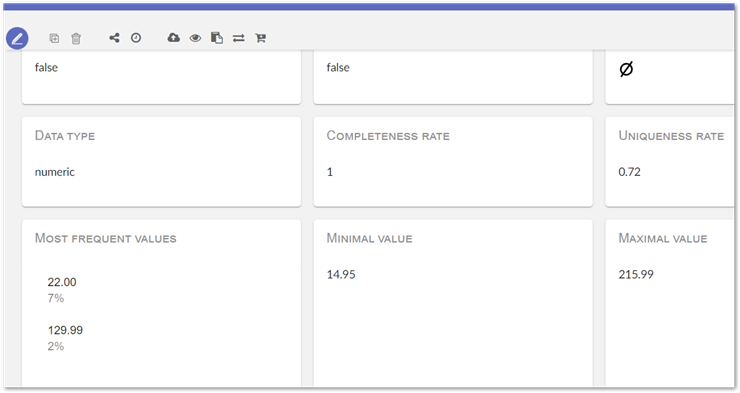
Run configuration
If you select Save and Run from the configuration view, you will start the harvesting. First the application needs to communicate with TDV, that’s why you will see the progress view.
After that, the progress table displays.
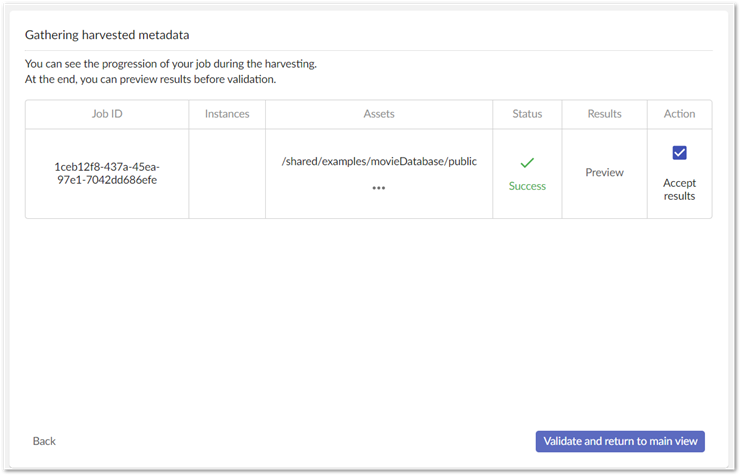
This table is auto-updated to display the status of the harvesting. You have multiple available actions:
In the Instances or Assets column, you can select the … to display the full list of instances/assets. The list displays in a pop-up. Click outside the popup to close it.
In the Results column, once the status is Success, you can select Preview to display harvesting results. If the status is Failed or In progress, this button is not available.
If results are correct for you, you can check the Accept results checkbox to approve them. This checkbox is checked by default.
Select Validate and return to main view to:
Accepts results and add them in the asset table if Accept results is checked. You will be redirect to the main view.
Reject results if Accept results is not checked. You will be redirected to the main view.
Click on the Back button to go back to the main view. From the main view, you will be able to return to this progress view if your harvesting is not validate yet.
Once you validate results, you will see on the main view that your configuration status is updated.
Use an existing configuration
From the main harvesting view, if you have existing configurations, the following actions are available:

1) | Run the configuration. You will see the progress view, then the progress table. |
2) | Schedule the configuration. |
3) | Configure the current configuration. You will see the configuration screen. |
4) | Extend the configuration with current selection. The configuration screen displays and the harvesting scope is merged with your current selection. |
5) | Duplicate the current configuration. A copy of this configuration displays on the configurations list. |

See the progress table view. This option is only available if the configuration status is Pending for approval.
Selecting Configure displays the configuration screen. This screen is similar to the one evoked in the Create a new configuration section but the instance/asset hierarchy, configuration name, configuration options are pre-populated. You will be able to change them and save it.
Schedule a harvesting
You can schedule one or several executions of an existing harvesting configuration. There are two ways to do so:
From the configuration view, after saving the configuration, by selecting Schedule on the bottom.

From the main view by selecting Calendar.

Clicking on the button displays a dialog box where you can configure the scheduling.
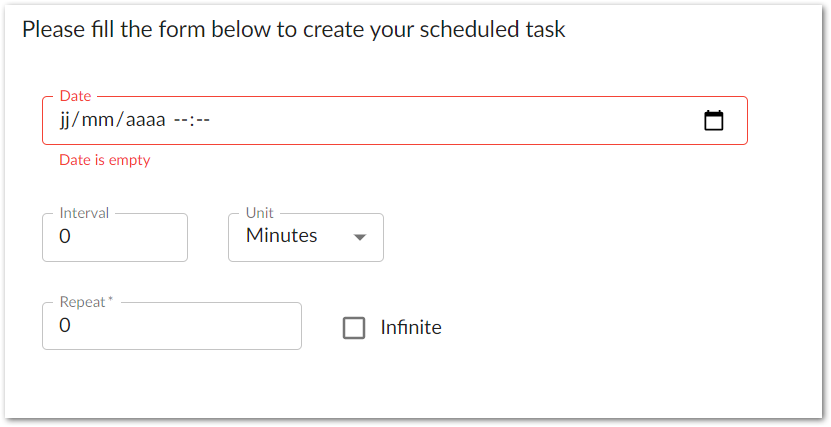
To save the scheduling you have to insert the date. Date This field is mandatory Insert the date and time here. You can use the arrow on the right to display the calendar. Interval between multiple scheduling if repeat is set. Unit of the interval. By default, it is in minutes but you can change it to hours or days. Repeat Number of repeats for the scheduling. To repeat this harvesting to infinite, check the Infinite checkbox.
Example: You want to schedule the harvesting every month. The date is 01/01/current year, interval 28 days and repeat is 12.
If you want to cancel harvesting, you have to be sure that the configuration is already scheduled. You can see it from the main view, the configuration will have the status Scheduled and the next execution date.

By selecting the calendar icon near the configuration, the schedule dialog box will display a Remove schedule button. Click on it to cancel scheduling.
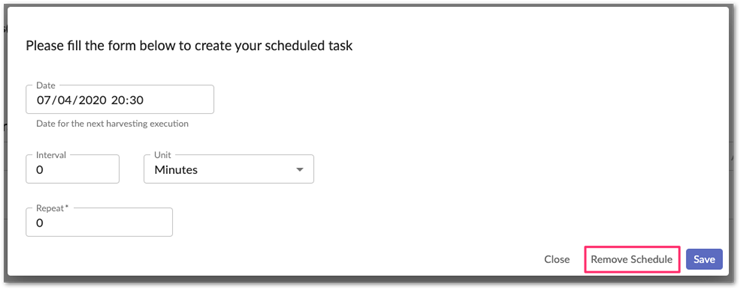
Create data source from instance
If you wish to harvest metadata for a data source that is not yet configured in TDV, you can configure it directly from the EBX® Metadata Management application.
Prerequisites
To do so, first you need to check that all necessary information is provided in the instance’s attributes and that the instance type is supported for creation by the EBX® Metadata Management application.
Currently, you can create:
relational data sources;
file-based data sources, such as Excel, XML, WSDL or CSV;
SOAP data sources;
REST data sources (for these data sources, manual creation of the operations is required in TDV after creating the data source).
A complete list of supported adapters is available in the Administration - Datasource Types table with attribute Creatable? = Yes.
An instance that you want to use to create a data source in TDV must provide necessary properties to connect to the physical data source from TDV. Below is the list of mandatory attributes depending on the type of the data source.
Create and harvest
Start creation of the new harvesting configuration for your instance as described in Create a new configuration section.
Click to expand children of the instance and the Create datasource button displays.
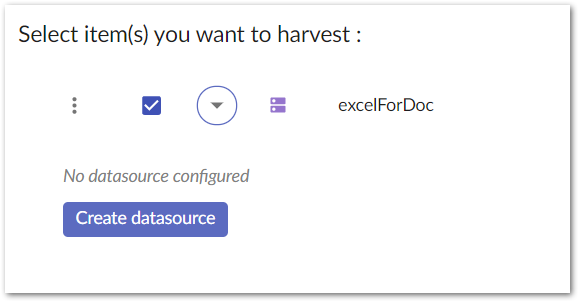
Click on it to show the list of available Metadata Agents. Click on the agent that you wish to use for data source creation to launch the process.

Wait for the process to complete. In case the creation was successful you will see a message Done in green. Finalize the process by selecting Finish.
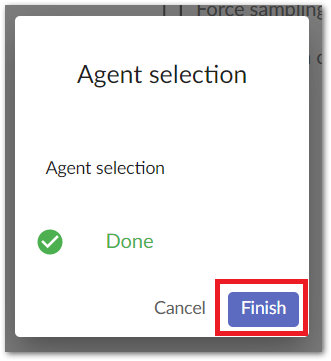
This should reload the harvesting screen and allow you to see the direct children of the instance.
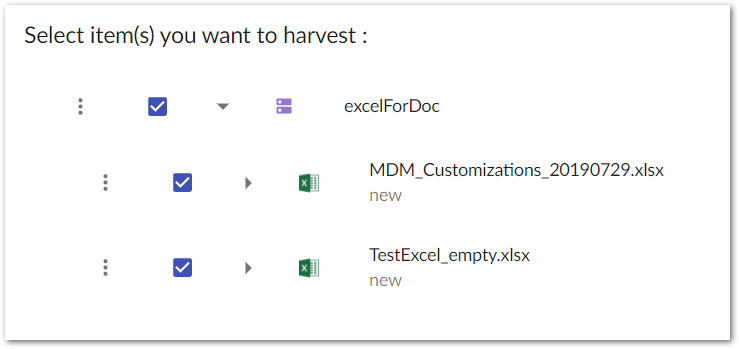
You can now continue with harvesting configuration as described in previous sections.
Specific Cases
Harvesting REST Resources
The EBX® Metadata Management application supports harvesting of REST resources documented manually in TDV. This comes with a specific behavior due to the way resources are documented in TDV. Indeed, the EBX® Metadata Management application represents REST resources according to the RESTful architecture which is not the case in TDV.
Here is the way REST Resources are displayed:
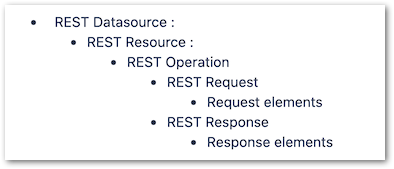
Harvesting configurations on Assets under Operation in the hierarchy are not possible since these resources are created by the agent and do not exist in TDV.
During the configuration of a harvesting from a REST Datasource, you will see all the operations registered in TDV, but no REST Resource asset as they are created by the EBX® Metadata Management application.